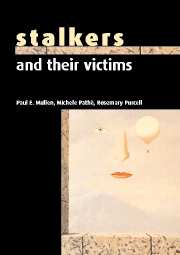Book contents
- Frontmatter
- Contents
- Acknowledgements
- Introduction
- 1 Stalking – a new categorization of human behaviour
- 2 The epidemiology of stalking
- 3 The victims of stalkers
- 4 Classifying stalkers
- 5 The rejected stalker and the resentful stalker
- 6 The predatory stalker
- 7 Intimacy seekers and incompetent suitors
- 8 The erotomanias and the morbid infatuations
- 9 Same gender stalking
- 10 Stalking by proxy
- 11 False victims of stalking
- 12 Stalking and assault
- 13 Reducing the impact of stalking
- 14 Defining and prosecuting the offence of stalking
- 15 Assessing and managing the stalker
- Appendix A Victim services
- Appendix B Important anti-stalking Acts/statutes
- Legal cases and references
- Index
4 - Classifying stalkers
Published online by Cambridge University Press: 05 March 2012
- Frontmatter
- Contents
- Acknowledgements
- Introduction
- 1 Stalking – a new categorization of human behaviour
- 2 The epidemiology of stalking
- 3 The victims of stalkers
- 4 Classifying stalkers
- 5 The rejected stalker and the resentful stalker
- 6 The predatory stalker
- 7 Intimacy seekers and incompetent suitors
- 8 The erotomanias and the morbid infatuations
- 9 Same gender stalking
- 10 Stalking by proxy
- 11 False victims of stalking
- 12 Stalking and assault
- 13 Reducing the impact of stalking
- 14 Defining and prosecuting the offence of stalking
- 15 Assessing and managing the stalker
- Appendix A Victim services
- Appendix B Important anti-stalking Acts/statutes
- Legal cases and references
- Index
Summary
Introduction
Classifications should not simply facilitate communication by giving names to items in a previously undistinguished landscape but should articulate relationships between conceptually similar groups as well as tell us something about what can be expected of each class. Classifications are in part creatures of convenience, which emerge within particular discourses and reflect not only the qualities of the things being classified but also the imperatives that operate in those discourses. In medicine, for example, classifications are generally diagnostic, being constructed on the basis of cause, course, outcome and, where possible, treatment. Diagnosis is used as a guide to prognosis and management. Diagnostic systems are usually subservient to those ends rather than to the purely theoretical goal of establishing mutually exclusive sets where membership in a given set, or class, is absolute with no room for vagueness or ambiguity. In any practical pursuit, such as those in which mental health professionals engage, classifications should serve the goals of the professional's clinical activities, not just the purer theoretical aims of the sciences that they mediate. Classifications of stalkers are likely to vary according to the needs of the group seeking to articulate the classification. For example, law enforcement officers, mental health professionals and advocates for the victims of domestic violence, all have legitimate concerns with stalking and stalkers; thus they have each evolved classifications that both further their ends and can be readily reconciled with the technical languages they habitually employ.
- Type
- Chapter
- Information
- Stalkers and their Victims , pp. 65 - 78Publisher: Cambridge University PressPrint publication year: 2000



